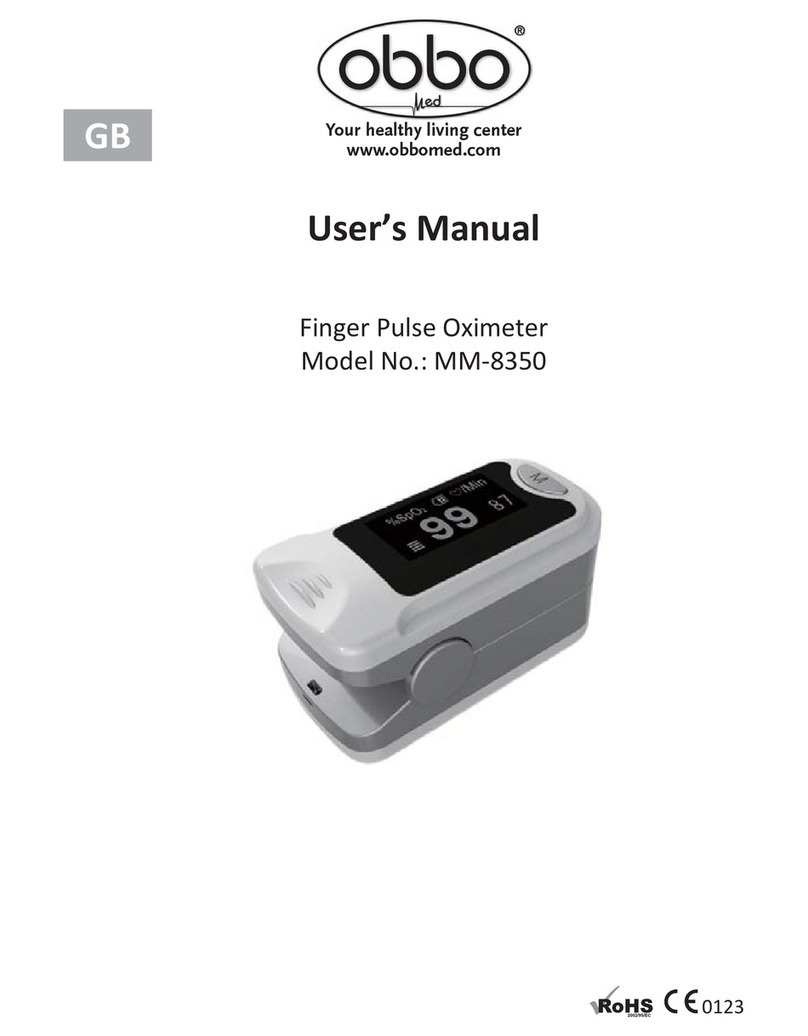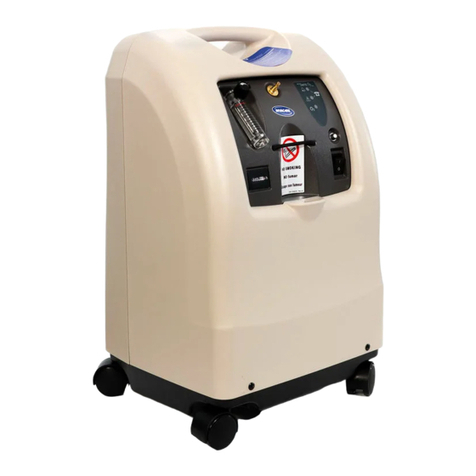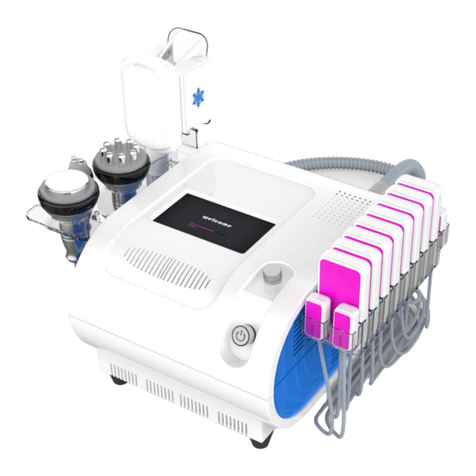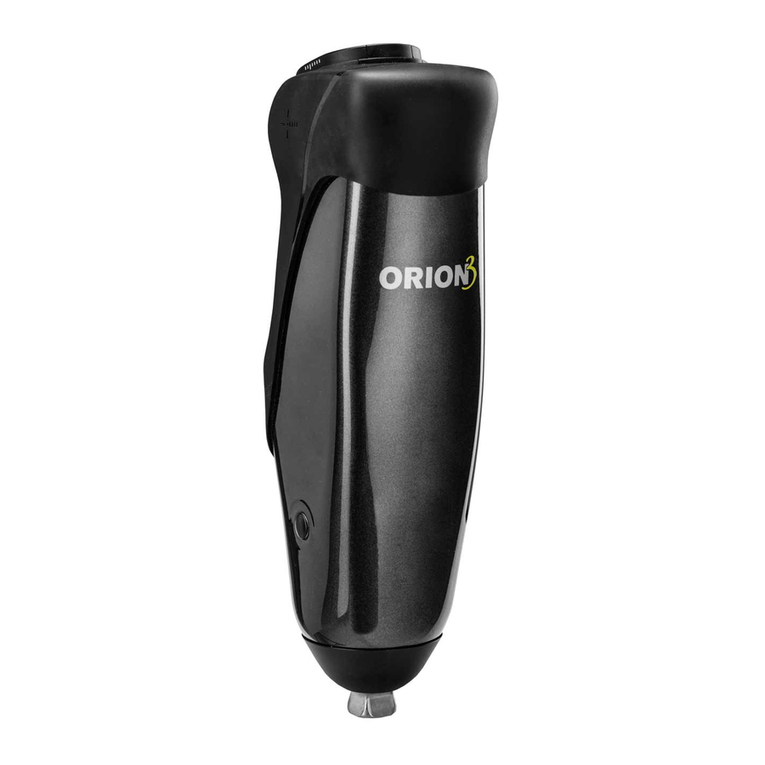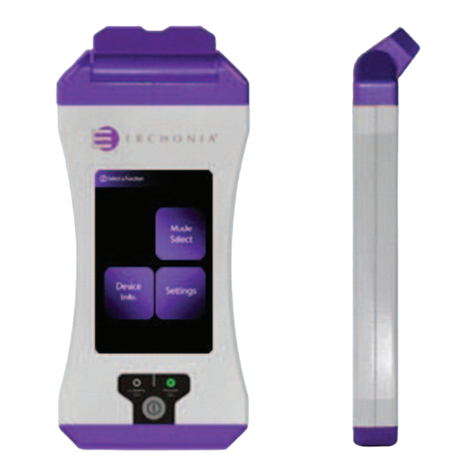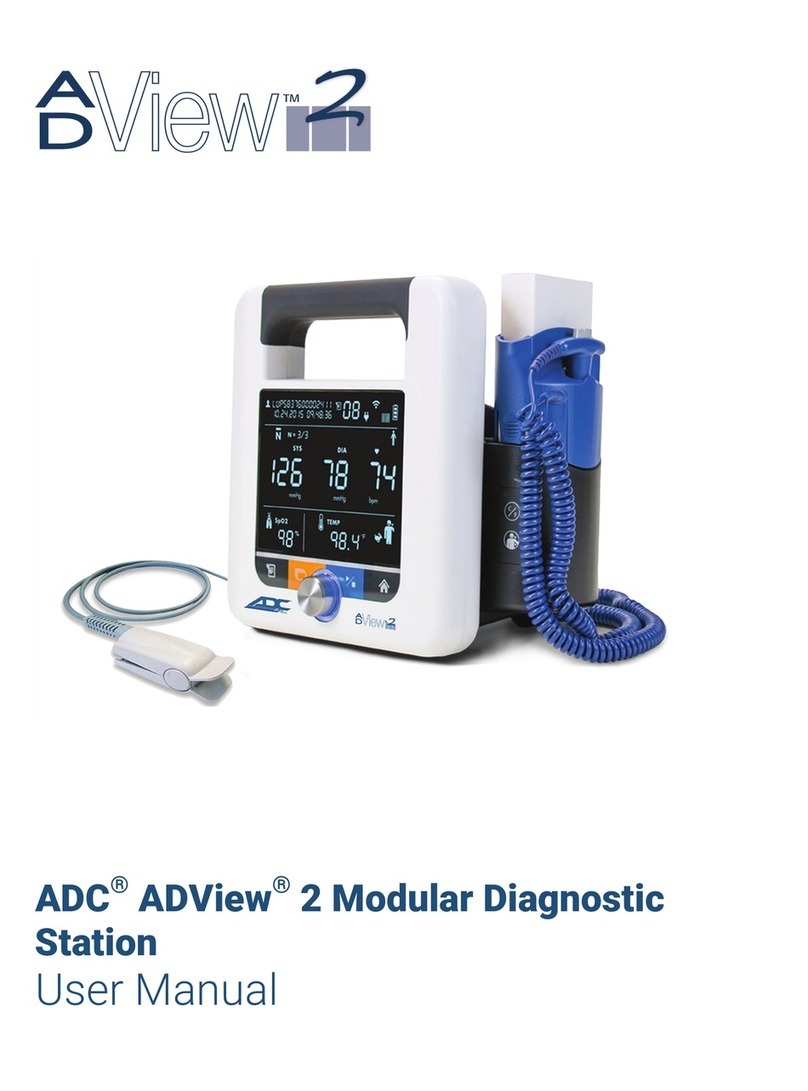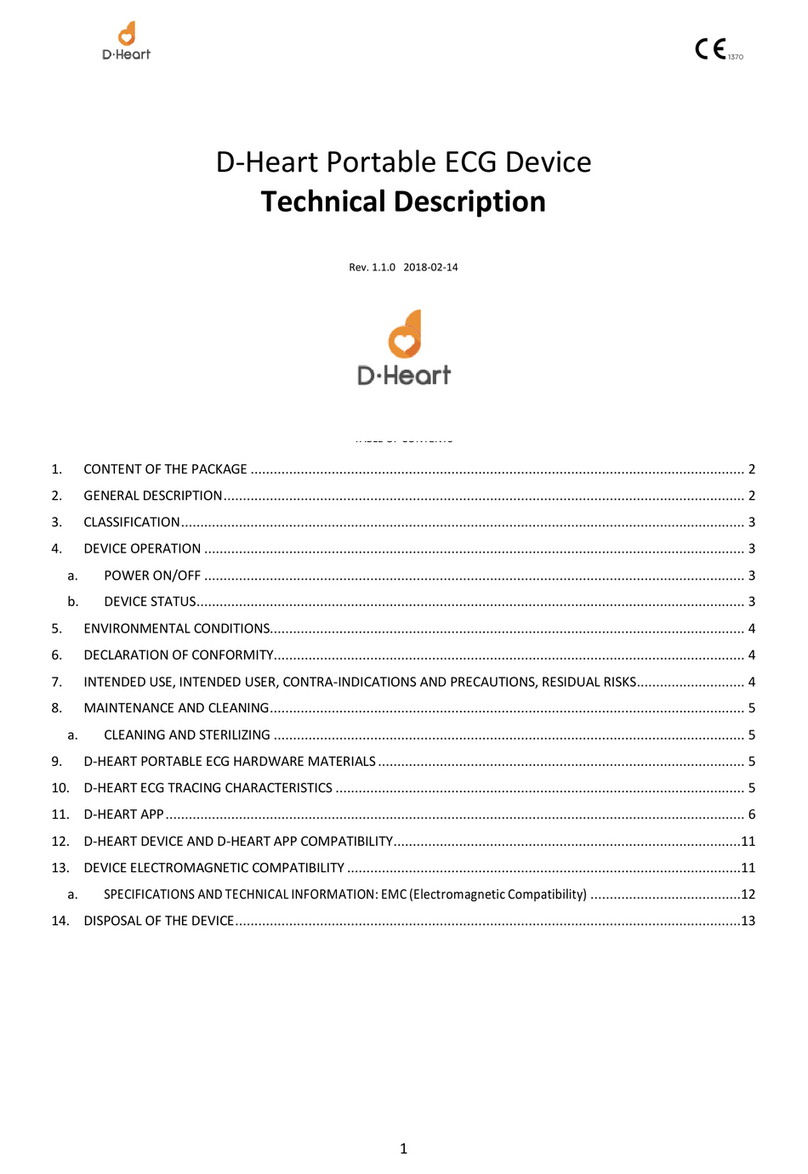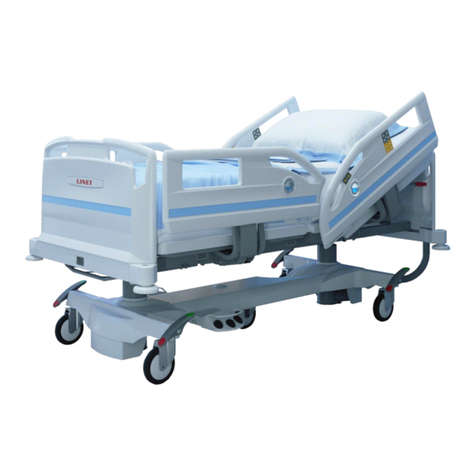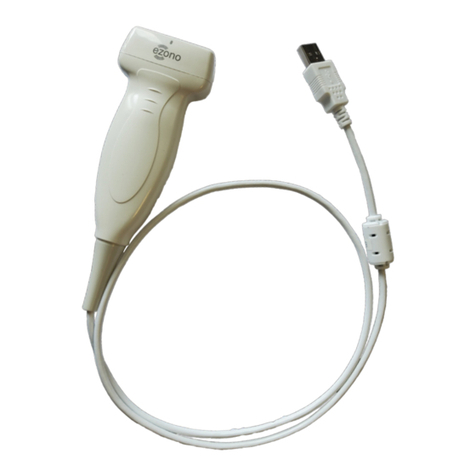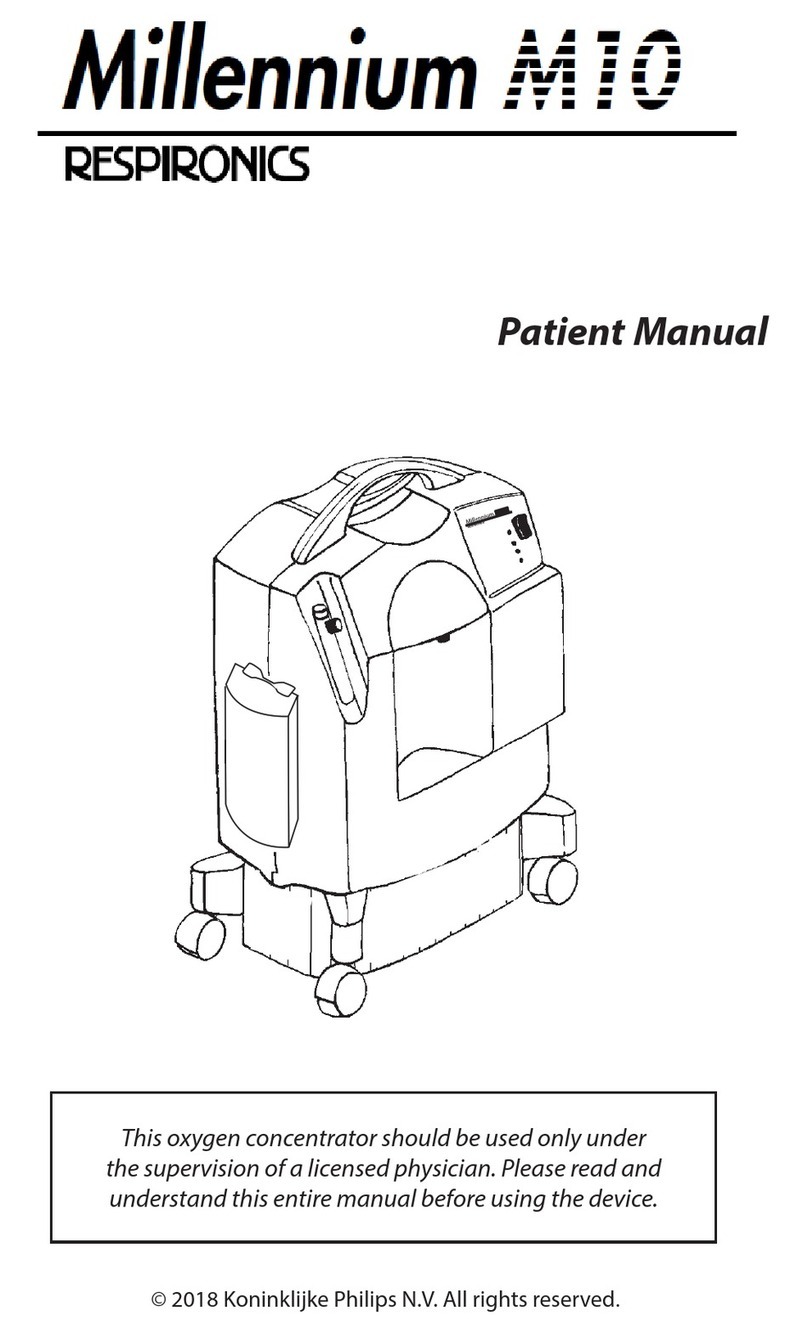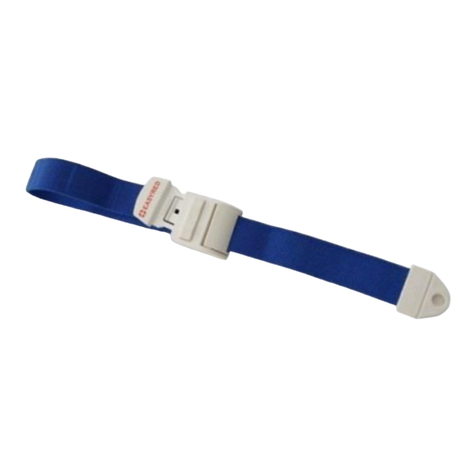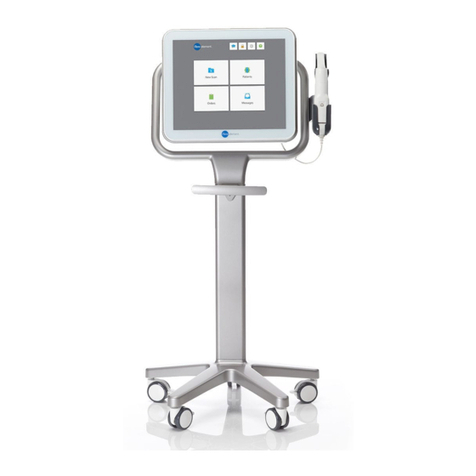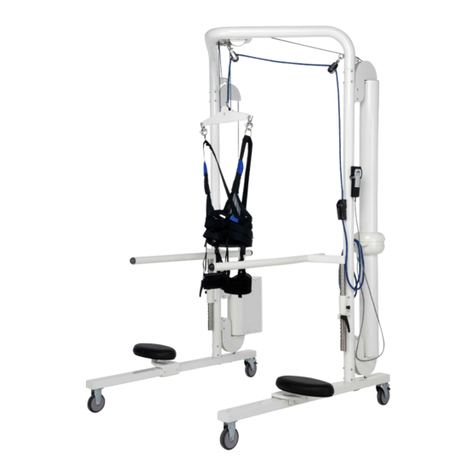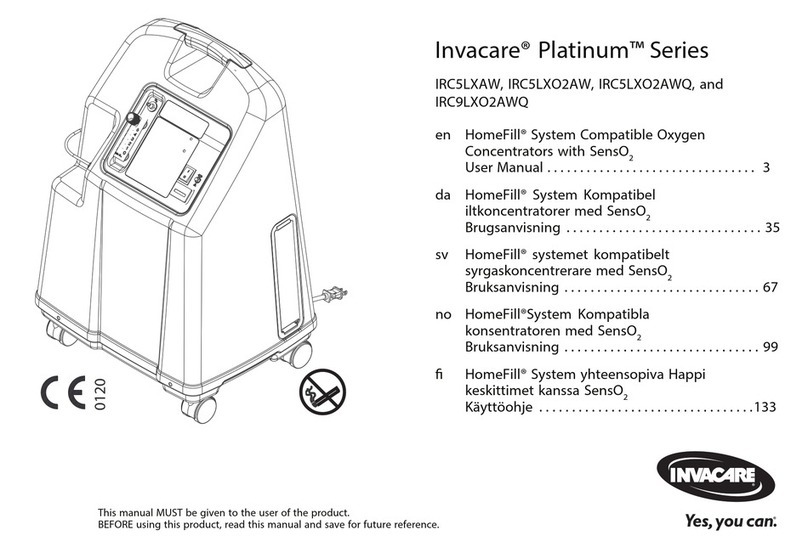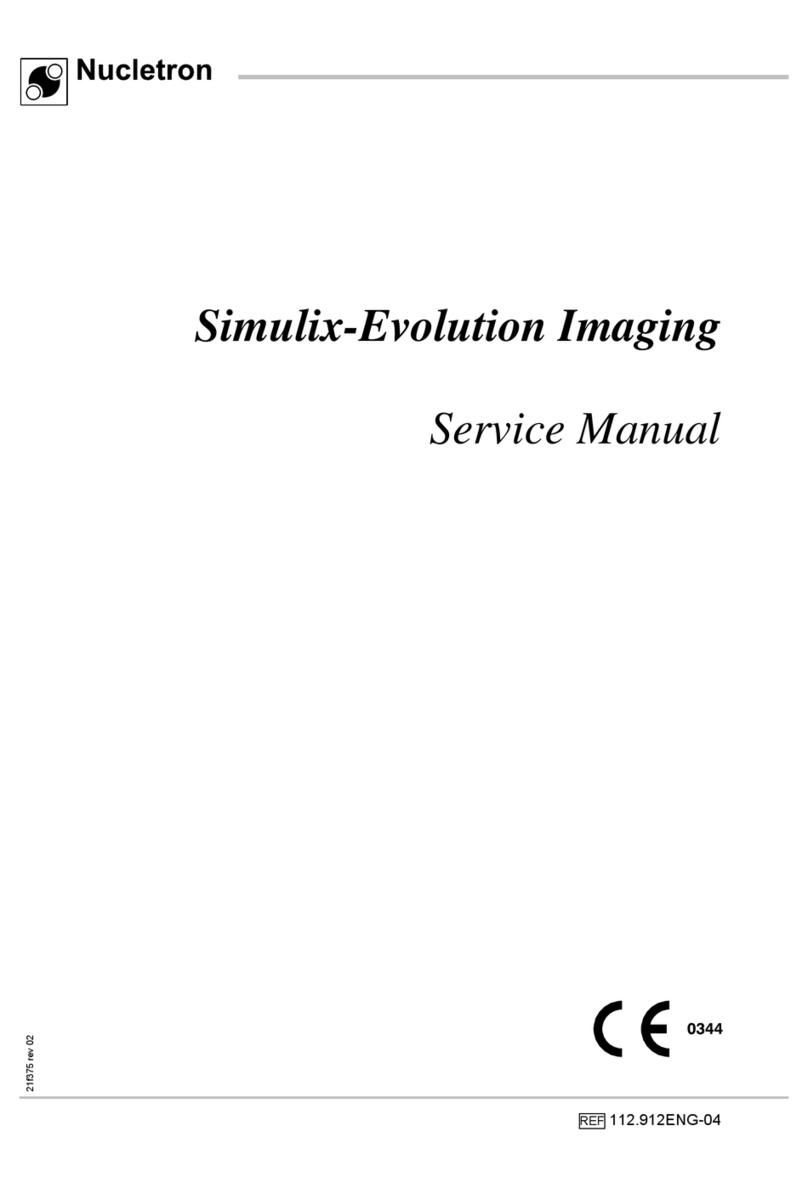Mackworth TX440 Advanced PT User manual

Doc No. 995674 Revision of document: A
Revision Date: 08/07/2021
TX Advanced Ceiling Track Hoist
Service Manual

Page 2of 63
Contents
1.0 Introduction ......................................................................................................................................................................................3
2.0 –Safety Precautions..........................................................................................................................................................................4
3.0 Servicing............................................................................................................................................................................................5
Program Mode Instructions....................................................................................................................................................9
Lift Tape Condition ...............................................................................................................................................................12
4.0 Test Procedure................................................................................................................................................................................13
5.0 Tools, Equipment and Lubricants Required for Servicing................................................................................................................14
6.0 Decommissioning............................................................................................................................................................................15
Hoist Removal ......................................................................................................................................................................15
Hoist Dismantling .................................................................................................................................................................15
Hoist Disposal.......................................................................................................................................................................15
7.0 Spare Parts List................................................................................................................................................................................16
8.0 Troubleshooting..............................................................................................................................................................................17
Hoist doesn’t turn on ...........................................................................................................................................................17
Hoist doesn’t charge.............................................................................................................................................................18
Hoist doesn’t Lift – No Error Message..................................................................................................................................20
Hoist doesn’t Lift – Up Inhibit! .............................................................................................................................................20
Hoist doesn’t Lift – High Current ..........................................................................................................................................20
Hoist doesn’t Lift – No lim_sw!.............................................................................................................................................21
Hoist is functioning but LCD and/or LED is inactive..............................................................................................................21
Hoist E-Lower Cord is not working .......................................................................................................................................22
Hoist has Power but does not respond to Handset commands............................................................................................22
Troubleshooting –Hoist Safety Mechanisms .......................................................................................................................23
9.0 Servicing –Removal and Replacement............................................................................................................................................24
External Covers.....................................................................................................................................................................24
PCB.......................................................................................................................................................................................27
Batteries...............................................................................................................................................................................30
Traverse Motor –Powered Traverse Hoist Only...................................................................................................................31
Lift Motor .............................................................................................................................................................................32
QRS Hook .............................................................................................................................................................................33
Bottom Cover .......................................................................................................................................................................34
Limit Switch..........................................................................................................................................................................36
Hub.......................................................................................................................................................................................38
Lift Tape................................................................................................................................................................................40
Wheels .................................................................................................................................................................................42
Traverse Shaft and Idle Gear (Powered Models Only)..........................................................................................................53
Charging Beak.......................................................................................................................................................................45
–Battery Lead Fuse ..............................................................................................................................................................52
Air Grommet ........................................................................................................................................................................55
Toggle switch........................................................................................................................................................................56
E-Lower cord ........................................................................................................................................................................58

Page 3of 63
1.0 Introduction
This Manual will explain how to carry out interim servicing and parts replacement on the Mackworth
TX Advanced Ceiling Track Hoist safely and effectively. This document is divided into sections to help
a Service Engineer find the correct information. Each section will show in a step by step fashion the
correct way to disassemble and assemble the Ceiling Track Hoist. The aim of the Manual is to advise
and assist you, so that you can provide a successful service for the end user.
The Mackworth TX Advanced is available in different configerations dependent on track profile. The
track profiles are shown below:
When Servicing the TX Hoist, one of the above track profiles should match.
The list below includes all types of TX that are covered by this Service Manual and which track type
they are suitable for.
TX400 Advanced Hoist Type
Track Type
TX600 Advanced Hoist Type
Track Type
TX440 Advanced PT –122617
Type 1
TX600 Advanced PT –122622
Type 1
TX440 Advanced PT –122656
Type 3
TX600 Advanced PT –122666
Type 3
TX440 Advanced PT –122659
Type 4
TX600 Advanced PT –122669
Type 4
TX440 Advanced PT –122662
Type 5
TX600 Advanced PT –122672
Type 5
TX440 Advanced QRT –122678
Type 1
TX600 Advanced QRT –122679
Type 1
TX440 Advanced QRT –122688
Type 3
TX600 Advanced QRT –122689
Type 3
TX440 Advanced QRT –122693
Type 4
TX600 Advanced QRT –122694
Type 4
TX440 Advanced QRT –122698
Type 5
TX600 Advanced QRT –122699
Type 5
TX440 Advanced RTC –122703
Type 1
TX600 Advanced RTC –122704
Type 1
TX440 Advanced RTC –122708
Type 3
TX600 Advanced RTC –122709
Type 3
TX440 Advanced RTC –122713
Type 4
TX600 Advanced RTC –122714
Type 4
TX440 Advanced RTC –122718
Type 5
TX600 Advanced RTC –122719
Type 5
TX440 Advanced MTCC –122616
Type 1
TX600 Advanced MTCC –122621
Type 1
TX440 Advanced MTCC –122655
Type 2
TX600 Advanced MTCC –122665
Type 2
TX440 Advanced MTCC –122658
Type 3
TX600 Advanced MTCC –122668
Type 3
TX440 Advanced MTCC –122661
Type 4
TX600 Advanced MTCC –122671
Type 4
TX440 Advanced MTCC –122664
Type 5
TX600 Advanced MTCC –122674
Type 5
TX440 Advanced PTCC –122619
Type 1
TX600 Advanced PTCC –122624
Type 1
TX440 Advanced PTCC –122657
Type 3
TX600 Advanced PTCC –122667
Type 3
TX440 Advanced PTCC –122660
Type 4
TX600 Advanced PTCC –122670
Type 4
TX440 Advanced PTCC –122663
Type 5
TX600 Advanced PTCC –122673
Type 5
TX440 Advanced MTPA –122615
Type 1
TX600 Advanced MTPA –122620
Type 1
TX440 Advanced PTPA –122618
Type 1
TX440 Advanced PTPA –122623
Type 1
Type 1
Type 2
Type 3
Type 4
Type 5

Page 4of 63
2.0 –Safety Precautions
Read and understand this manual in its entirety before servicing the Mackworth TX Advanced
Hoist.
•Mackworth authorised personnel must complete the Full and Interim services of the TX
Advanced Ceiling Track Hoist.
•The Hoist must not be in use by the user during any form of servicing.
•The Hoist must be turned OFF during any servicing that requires the external covers of the
Hoist to be removed, or any dismantling of standard parts.
•Always ensure suitable clearance to remove the Hoist from the ceiling track.
•Ensure that the all servicing procedures are followed correctly as instructed in this manual.
•All listed tools and equipment stated in this manual must be used to safely service this Hoist.
•Ensure you have assessed all risks for your environment and any persons within that
environment before commencing work.
•Ensure you have all PPE available to carry out the work before commencing.

Page 5of 63
3.0 Servicing
To be completed by Approved Service Engineer
Maintenance should be completed by an approved service engineer every 6 months to ensure the
products required standard is maintained. The service history of the product should be documented
each service.
When Servicing the Ceiling Track Hoist, ensure to fill out the Service Log which is located in the back
of the User Manual. When doing so, ensure the Serial Number of the Product and the User Manual
match up. Each Ceiling Track Hoist has its designated User Manual which is supplied to the User
during commissioning.
Component
Service/Inspection required
Generic:
Visual inspection of the externals of the Ceiling Track Hoist. Significant
damage that may affect the function of the Hoist along with a clear
safety hazard is unacceptable.
Check the Labelling on the Hoist to ensure they are all still legible, this
includes the Serial Number and other important markings.
Clean the Hoist at the end of each service. See User Manual for
cleaning details.
Check all main nuts and bolts, screws and fixing to see if they are
loose, if so tighten accordingly.
Lift Motor:
Inspect the components for damage that may affect the function and
safety of the product.
Listen for any unusual sounds when operating the Motor, this should
be done loaded and unloaded.
Fully Lift and Lower the Hoist to ensure that the Motor is performing
as intended. The lifting and lowering speed should be fairly consistent
throughout the motion of travel.
Ensure the Manual Emergency Lowering Device is performing.
Hub and Gearing:
Ensure that the Hub gearing is in good condition, excess wear should
be cleaning and an inspection on the condition must be conducted to
ensure the gearings are in a safe condition until the next service.
The Hub should be re-greased during service.
Ensure that the meshing of the Hub and Motor gearing is smooth.
Test the function of the Over-Speed Cam. Using a small Allen Key, place
it through the slot in the Chassis and test the functionality of the Cam
by pushing it outward. The Cam should automatically spring back to
position once the force has been removed.
Lift Tape:
Inspect the full length of the Lift Tape for any damage such as fraying.
See section 3.2 below as a reference for unacceptable wear.
There must be no signs of failure to the stitching of the Lift Tape, this
is most noticeable at the lowered where the Carry Bar is attached.
Toggle Switch:
Ensure that the Emergency Stop can be activated by pulling the E-
Lower Cord down one step. The operation should be smooth and can
be reversed when pressed back to the ON position.
Ensure that the emergency lower is functioning when activated. When
released it must become jammed in the E-Lower position.

Page 6of 63
Limit Switch:
Fully lower the Lift Tape to reach maximum length, at this point the
lower limit switch should be activated and stop the Hoist. The LCD
should display the message: “Down Lim_Sw!”
Fully raise the Lift Tape to reach minimum length, at this point the
upper limit switch should be activated and stop the Hoist. The LCD
should display the message: “Up Lim_Sw!”
Lower the Lift Tape without any load (do not remove the carry bar),
the Lift Tape should reach the bottom limit without any issues. If the
Hoist performs a stop/start motion, the limit switch may be damaged.
Remove the Carry Bar, the Limit Switch should display “Down
Lim_Sw!”
Carry Bar:
Inspect the Carry Bar for damage, this includes deformation, cracking
or large dents that may affect its function or safety.
Ensure that the Carry Bar Spring Clips remain functional.
No sharp edges shall be found on the Carry Bar as this has the potential
to damage the Slings.
Ensure that the Carry Bar is fitted to the QRS Hook correctly. Refer to
the User Manual for correct attachment.
Handset:
Inspect the components for damage that may affect the function and
safety of the product.
Verify that all the Handset controls are functioning.
Ensure that the Handset is connected to the Hoist correctly and that
the connections are secure.
PCB and electrics:
Inspect the PCB for any electrical burns.
Ensure that all the wires are connected to the PCB correctly, as well
any other wire connections.
Inspect all wires for any damage.
Ensure that the Air Tubes are connected to the PCB and Air Grommet
properly, as well as being fitted to the correct air switches. Ensure that
there are no cuts in the Air Tubes.
LED Indicator:
Ensure that the LED is functioning correctly. See the Display message
table in the User Manual to confirm.
Ensure that the LED is not cracked or damaged.
LCD Display:
Ensure that the LCD is functioning correctly. See the Display message
table in the User Manual to confirm.
Ensure that the LCD Display is not cracked or damaged. The display text
should be legible.
Using the Display Screen and Handset, enter the program mode to
view the Hoist data, such as total lifts. The relevant information should
be filled into the service log.
Enter the program mode to ensure that the pre-set amps have not
been altered. Or edit the amps when required.
Enter the program mode to reset the preventative maintenance. For
guidance using the program mode, see section 3.1.
Charging:
Check that the Charging beak is able to dock into the charging dock
smoothly without excess force.
Ensure the Charging is active when the Hoist is docked into the
charging dock. The Hoist LED will flash orange along with the display
stating it is “charging”, or it will display “charged” which will result in a
LED displaying Green.
Ensure that there are no exposed wires from the charging dock or port.

Page 7of 63
Batteries:
If the Hoist is having power issues or difficulties charging, the Battery
voltage should be measured using a Voltmeter to determine the status
of the Batteries.
Test the batteries on the Hoist using the battery tester to see if they
still hold charge properly, test the two batteries while running the
Hoist to see if they equally draw charge.
Check for any damage or leaks on the Batteries.
Wheels:
Examine the products Wheels for signs of damage or wear, ensure they
run freely and are not cracked.
Ensure the product is able to traverse freely with ease.
Powered Traversing:
Ensure that the Hoist is able to Power Traverse along the Track
smoothly without issues, such as stop/starting.
Ensure that the Powered Traverse is able to dock into the Charging
Dock correctly.
Ensure that the direction of Powered Traversing corresponds
correctly with the directional arrows on the Bottom Cover.
Communications Port:
Ensure that the Communications Port is not damaged, such as cracks
or burns.
Ensure that the Communications Port is functional with the given
accessory.
Return to Charge:
Ensure that the function of the return to charge is functional when
operated.
Ensure the RTC docking is successful and charging occurs.
Quick Release System:
Ensure that the QRS attachment to the Trolley is safe and as
intended. See User Manual for correct attachment procedure.
Inspect the traversing of the QRS Trolley, ensure the traversing is
smooth.
Constant Charge:
Ensure that the Constant Charge Beak is in contact with the Ceiling
Track Charging Strips.
Inspect the Beak for damage that may affect its function or safety.
Ceiling Track:
Perform a quick inspection on the Ceiling Track to ensure that the
Hoist is safe for use on the Ceiling Track.
Assess all track fixings to ensure they are safe for use until the next
service.
Ensure the joints between the two track sections (if any) have no gap
between them and that they are smooth and level. If there is a rough
transition, use a small file to blend the two surfaces for smooth
transition.
Ensure that the Installation of brackets are correct and fitted properly,
as well as the correct amount of brackets have been installed. If
necessary, tighten the bracket screws with a 3mm Allen Key.
Ensure that the Bolt Ends Stops have been installed in the track for
safety. Tighten the bolts if necessary. If non-existent, see Installation
manual on how to install. The end stop is a safety component that
ensure the Hoist is confined to the track.
If the track is up against the wall, ensure that a track bolt has been
fitted correctly. If non-existent, see Installation manual on how to
install.
Clean the internal of the Ceiling Track if there is any debris that could
affect the function of the Hoist.

Page 8of 63
Slings:
Inspect the applied sling thoroughly with regards to the following
points:
-Any damage such as cuts, frays, tears, burns on the sling or
sling straps
-Any sign of stitching failure, where the fabric is found to be
stretching, tearing and coming undone
-Are the straps fully intact
-The labels and serial numbers should all be legible.
If there is a problem discovered with the sling, it should be noted on
the service sheet and be brought to the attention of the person(s) who
requested the service to be carried out. In addition, notify the
customer on-site or the Manager if it is a care facility. The serial
number, type of sling, and condition should be noted on the service
sheet. Mark the date of inspection on the sling service label.

Page 9of 63
Program Mode Instructions
Use the flow chart below to access and edit all settings within the Program Mode.

Page 10 of 63

Page 11 of 63

Page 12 of 63
Lift Tape Condition
In this section the images below will show two types of lift tape condition, one in which the wear is
minimal and therefore in an acceptable condition, whereas the other Lift Tape has a level of wear
which is unacceptable and requires a change during the current service.
Acceptable Condition
It can be seen there is a very small amount of
wear to the tape but nothing substantial that
requires an immediate Lift Tape replacement. It
is advised the Service Engineer informs the
Customer of the dangers of Lift Tape fraying
and that they keep an eye on the tapes
condition.
Unacceptable Condition
In the first image you can see a clear increase in
wear with additional fraying. This is the start of
the Lift Tape starting the fraying process which
will only increase each lift. If the Lift Tape is
discovered in this condition or worse, at any
point along the tape, the Lift Tape should be
replaced immediately.
The second image is an example of extreme
wear which is a condition the Lift Tape should
never be allowed to reach. This condition is
endangering the safety of the patient.

Page 13 of 63
4.0 Test Procedure
Below is the full testing procedure required to complete an Annual Hoist Service.
The SWL of either 200kg or 272kg (440lb / 600lb) is an essential load for the testing of the Hoist. A
mode of transportation to transport the weights to the Hoist is required.
The weights must be attached to the Hoist carry bar securely and follow the below procedure in
order:
1. Raise the Weight to the Hoist Upper Limit. Be aware of any unusual noises while raising the
Safe Working Load.
2. Lower the weight to a safe height, but still fully suspended from the Hoist.
3. Traverse the Hoist around the full track system and observe. Watch for any abnormalities
such as noise or traversing trouble. Also inspect the track system for any abnormalities such
as creaking, cracking, traversing the whole track system should test every bracket and
accessory to the tracking system, observe for any fragilities in the brackets and supports.
4. Dock the Hoist with the suspended weight in the Charging Dock. Ensure the Hoist is charging
correctly. (With Constant Charge, check the charging occurs at the current location). (With
RTC, activate the function and allow the Hoist to traverse into the Dock).
5. Traverse the Hoist out of the Dock.
6. Begin to lower the Hoist using the down function on the Handset.
7. Pull the E-Lower Cord to test the E-Stop function.
8. Pull the E-Lower Cord again and continue to hold to test the E-Lowering function.
9. Lower the Hoist using the down function on the Handset until the weight can be detached.
10. Continue to lower until the lift tape has been fully extended to test the lower limit switch.
11. Raise the Hoist back to its original height.
12. Traverse the Hoist back into the Charging Dock without weight to test docking. Ensure the
Hoist can dock properly unloaded. (With Constant Charge, check the charging occurs at the
current location). (With RTC, activate the function and allow the Hoist to traverse into the
Dock).
13. For Powered Auxiliary Hoists, test the interaction of the Hoist with the accessory and ensure
that the communication is successful. If the accessory is damaged, refer to the service
manual for the specific accessory at hand.
14. Traverse the Hoist back to its starting position.
15. Test Complete.

Page 14 of 63
5.0 Tools, Equipment and Lubricants Required for
Servicing
When carrying out work on the Mackworth TX Advanced Hoist, you will require the following:
Tools Required
2mm Allen Key
2.5mm Allen Key
3mm Allen Key
4mm Ball Ended Allen Key
5mm Allen Key
8mm Spanner
No. 2 Pozi Drive Screwdriver
2mm Slotted Screwdriver
5.5mm Slotted Screwdriver
External Circlip Pliers 3-10mm
Long Nose Pliers
Side Snips
Digital Vernier Calliper
Tape Measure
Second Cut Hand File
Power Drill
8.5mm Drill Piece
Equipment Required
Step Ladder
Multi-Meter
Battery Tester
Marker Pen
Cloth
Lint Free Cloth
Service Documentation
Product User Manual
Product Spare Parts Manual
Product Commissioning Manual
Test Weights –200kg/400lb or 272kg/660lb
Weight Trolley
Lifting Straps x2 (Attach weight to Carry Bar)
Service Stand
Grease Gun
Cable Ties –100x2.5mm (Part No. 000106) x 4
Lubricants and Sundries Required
Morris Grease –k42EP Multi- Purpose Grease
Loctite 222
Loctite 243

Page 15 of 63
6.0 Decommissioning
The following section will instruct on how to correctly decommission the TX Advanced Hoist at the
end of use. This section is relevant to both the TX440 Advanced and TX600 Advanced.
The product may be contaminated and has to be disinfected before decommissioning.
See section ‘Cleaning’ in the User Manual for details of how to do this.
Hoist Removal
To successfully remove the Hoist from the Ceiling Track, refer to the Commissioning Manual for full
details. A summary of the correct order on how to remove the TX and its components has been
listed below. It is highly recommended that the Commissioning Manual is used to ensure a safe
removal.
1. Turn OFF the Hoist by pulling down the E-Lower Cord to its middle switch.
2. Detach the Carry Bar from the Hoist.
3. Detach the Handset from the Hoist
4. At the end of the Track, remove the End Cap, Safety Bolt and End Stop.
5. Carefully slide the Hoist out of the Track.
6. Turn OFF the Charger at the Wall Socket and remove the plug.
7. Remove the charging unit from the wall using a pozi head screwdriver.
8. Detach and carefully slide the Charger out of the Track.
9. Ensure the End Stop, Safety Bolt and End Cap are refitted to the Track once all the above
steps are complete.
10. Hoist Removal is complete.
Hoist Dismantling
All serviceable components of the Hoist should be dismantled prior to the disposal of the Hoist. For
guidance on how to dismantle all of the Hoist components, refer to section 9.0 –Servicing within this
manual for removal and replacement details. Each sub-section will give in depth details on how to
dismantle each component of the Hoist.
Hoist Disposal
When the Hoist has completed its life cycle and can no longer perform to its
intended use safely the Hoist must be decommissioned by an approved Service
Engineer. The following specifies the importance of correct disposal procedure
including local laws and being environmentally friendly.
Please observe the local laws on recycling and respect the current laws for disposal
within the community the device is being used within. If there is any uncertainty of
the below guidelines, contact your local authorities to determine the proper
method of disposal of potentially biohazardous parts and accessories.
The relevant components utilised in the manufacture of the device that can be recycled at the end of
the device life are:

Page 16 of 63
Fully recyclables:
Consideration when Recycling:
Chassis
Batteries
Plastic Covers
Wiring Looms –electronics
Metallic Internals –Hub etc.
PCB
Initial packaging of the device (cardboard)
Hand Control
Metallic fixing –Screws etc.
Motors
Plastic Mouldings –Wheels etc.
Lift Tape
Carry Bar
Charger
Ensure that this list is used as guidance and that the local laws in the given community overrule the
suggested component disposal in the table above.
7.0 Spare Parts List
For the full list of Spare Parts available for this product. Please refer to the latest revision of the
Spare Parts Manual.
Document Number: 992674
The Spare Parts Manual can be located on the Mackworth Website: http://mackworthusa.com

Page 17 of 63
8.0 Troubleshooting
Should a problem arise with the use of the Hoist, this section offers guidance to all known faults
revolving the product. The list of faults below offers the correct actions in sequence to resolve the
issue.
For each step per scenario, if the step does not determine the issue, continue to the following step
in sequence until the fault is found. Once the fault is found, refer to the action guide with the
corresponding number to resolve the issue. After following the correct action, check that the Hoist is
now functioning correctly, and perform a simple test. See Section 4.0 for correct test procedure.
For guidance on how to dismantle the Hoist to perform troubleshooting actions, see section 9.0 –
Servicing.
If the fault is not found and/or the solutions do not correct the problem, contact your local
Mackworth authorized dealer immediately.
Hoist doesn’t turn on
Operate the handset to determine if the Hoist powers up. If it does not –Follow the Troubleshooting
guide below.
Troubleshooting Guide
1. Check the Handset is correctly connected to the Air Grommet.
2. Check the Handset air tube is not damaged, e.g. cuts and holes.
3. Check the E-Lower Cord has not been used, this will leave the toggle switch in OFF mode.
4. Doc the Hoist into the Charger to see if the Hoist begins to Charge, it is possible the Hoist is
out of battery.
5. Check the Battery Lead connection points are connected properly, from battery to PCB.
6. Check for any damage to the battery leads, e.g. cuts and breaks.
7. Check to see if the Fuse on the Battery Lead has blown.
8. Check the Limit Switch Wires for any damage, cuts and breaks. For thorough inspection,
removal is recommended. See section 9.7 for guidance.
9. Perform a visual check on the PCB for any damage, e.g. blown components.
10. Using a Battery Tester, check that both Batteries are providing around 12V to the PCB.
11. Replace current PCB.
12. Replace current Limit Switch Block.
13. Replace current Toggle Switch.
Action Guide
1. Re-attach the Handset to the Air Grommet –See User Manual on Handset attachment.
2. Remove the Handset from the Hoist and Replace –See User Manual on Handset attachment.
3. Press the red tab vertically to switch the toggle switch from OFF to ON.
4. If Hoist LED flashes orange, use Handset to attempt to turn on Hoist. If unsuccessful,
continue Troubleshooting Guide and refer to the section on “Hoist not Charging” as this is
likely the guide to resolve the issue. If Hoist turns on, allow the Hoist to charge before
testing. If Hoist does show signs of charging but does not turn on, continue this
Troubleshooting Guide.

Page 18 of 63
5. Re-attach the Battery Leads as shown in section 9.3.
6. Remove the Battery Leads and Replace as shown in section 9.3
7. Replace the Fuse as shown in section 9.12
8. Replace the Limit Switch Block –See section 9.7
9. Replace the PCB –See section 9.2
10. If voltage is below 12V. Replace the Batteries –See Section 9.3
11. See section 9.2 on PCB replacement.
12. See section 9.7 on Limit Switch Block replacement.
13. See section 9.14 on Toggle Switch replacement.
Hoist doesn’t charge
Dock the Hoist correctly (ensure the beak is making contact with the Dock) to determine if the Hoist
will charge, if the display does not show “charging” or the LED does not flash orange, follow the
Troubleshooting Guide below.
Troubleshooting Guide
1. Check the Charger is turned on at the power supply –the charging unit LED should show a
steady green light when turned on, and flashing orange when the Hoist is charging.
2. Check Charger wiring for damage, e.g. cuts and breaks.
3. Check Voltage and Current through the Charging Dock.
4. Check the Charging Beak is not damaged, e.g. Cracks, breaks, Contact Strips are intact.
5. Check Charging Beak wiring from the beak to the PCB for damage or disconnection.
6. Check PCB for damage near the Charging Beak connection point, e.g. blown components.
7. Check the Batteries output using a Battery Tester.
8. Replace Charging Beak
9. Replace Charger
10. Replace PCB
Action Guide
1. Turn the Plug Switch at the wall on.
2. Replace Charger Assembly. See Installation Manual for Charger installation.
3. Use a Voltmeter and Ammeter to determine the Voltage and Amps of the Charging Dock, the
voltage should show 24VDC. Amperes should show 1A. If there is no Voltage or Current
running through the Charger, check the Fuse in the Plug. Replace if necessary. If there is no
fault to be found, replace the Charging Doc Unit. See the Installation Manual to install
Charger
4. Replace the Charging Beak. See Section 9.11
5. If the wire is damaged, replace the beak (see section 9.11), if wiring is disconnected from
board, re-connect correctly (see section 9.11)
6. Replace the PCB –See section 9.2
7. If Batteries or non-responsive, replace the batteries.
8. See section 9.11 for Charging Beak replacement.
9. See Charger Installation within the Installation Manual.
10. See section 9.2 on PCB replacement.

Page 19 of 63
Hoist doesn’t charge – Constant Charge
Do not operate the Hoist and allow the Hoist to charge at its current location. If the display does not
show “charging” or the LED does not flash orange, follow the Troubleshooting Guide below.
Troubleshooting Guide
1. Check the Constant Charge Charger is turned on at the power supply –the charging unit LED
should show a steady green light when turned on, and flashing orange when the Hoist is
charging.
2. Check that the Constant Charge Beak is in contact with the Ceiling Track charge strips.
3. Check Charger wiring for damage, e.g. cuts and breaks.
4. Check Voltage and Current through the Charging Dock.
5. Check the Constant Charge Beak is not damaged, e.g. Cracks, breaks.
6. Check the Constant Charge Strips within the Track are not damaged, e.g. poor connections,
broken strips.
7. Check Charging Beak wiring from the beak to the PCB for damage or disconnection.
8. Check PCB for damage near the Charging Beak connection point, e.g. blown components.
9. Check the Batteries output using a Battery Tester.
10. Replace Charging Beak
11. Replace Charger
12. Replace PCB
Action Guide
1. Turn the Plug Switch at the wall on.
2. Inspect the Beak for damage that may cause the lowered height. Replace if necessary.
3. Replace Charger Assembly. See Installation Manual for Charger installation.
4. Use a Voltmeter and Ammeter to determine the Voltage and Amps of the Charging Dock, the
voltage should show 24VDC. Amperes should show 1A. If there is no Voltage or Current
running through the Charger, check the Fuse in the Plug. Replace if necessary. If there is no
fault to be found, replace the Charging Doc Unit. See the Installation Manual to install
Charger
5. Replace the Charging Beak. See Section 9.12
6. See the Installation Manual for the specific ceiling track for service and repairs to the
constant charge strip.
7. If the wire is damaged, replace the beak (see section 9.12), if wiring is disconnected from
board, re-connect correctly (see section 9.12)
8. Replace the PCB –See section 9.2
9. If Batteries or non-responsive, replace the batteries.
10. See section 9.12 for Charging Beak replacement.
11. See Charger Installation within the Installation Manual.
12. See section 9.2 on PCB replacement.

Page 20 of 63
Hoist doesn’t Lift –No Error Message
Attempt to raise/lower Hoist with handset, the LCD Displays the message “up” “down”, but Hoist is
not responding. Follow the Troubleshooting Guide below.
Troubleshooting Guide
1. Check the Lift Motor Wires are connected properly between the Toggle Switch and Motor.
2. Check for damage along the Motor Wires, e.g. Cuts and breaks.
3. Check for damage along the two Toggle Switch Wires which provide power to the Lift Motor.
4. Check Lift Motor gearing inside the Hoist for damage. The teeth could be worn down and no
contact is being made with the Hub.
5. Check Hub teeth for damage. The teeth could be worn down and no contact is being made
with the Lift Motor.
6. Check PCB for damage near the Toggle Switch, e.g. blown components.
7. Replace Lift Motor.
8. Replace PCB
9. Replace Toggle Switch
Action Guide
1. Connect the Motor Wires and Toggle Switch Wires correctly. See 9.4 for guidance.
2. Replace the Lift Motor. See section 9.4 for guidance.
3. Replace the Toggle Switch. See section 9.14 for guidance.
4. Replace the Lift Motor. See section 9.4 for guidance.
5. Replace the Hub. See section 9.8 for guidance.
6. Replace the PCB. See section 9.2 for guidance.
7. See section 9.4 on guidance to replace the Lift Motor.
8. See section 9.2 on guidance to replace the PCB.
9. See section 9.14 on guidance to replace the Toggle Switch.
Hoist doesn’t Lift – Up Inhibit!
Attempt to raise/lower Hoist with handset, the LCD Displays the message “Up Inhibit!” Follow the
Troubleshooting Guide below.
Troubleshooting Guide
1. Batteries require immediate charging.
Action Guide
1. Place the Hoist on charge.
Hoist doesn’t Lift –High Current
Attempt to raise/lower Hoist with handset, the LCD Displays the message “High Current” and the
alarm beeps for 3 seconds. Follow the Troubleshooting Guide below.
Troubleshooting Guide
1. Check Program Mode to determine if the Load is set to 24 Amps.
2. Inspect the internal gearing between the Hub and Lift Motor for wear, swarf and damage.
This manual suits for next models
58
Table of contents
Other Mackworth Medical Equipment manuals
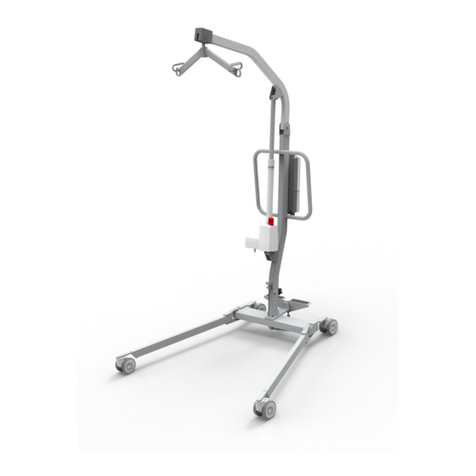
Mackworth
Mackworth M180 User manual
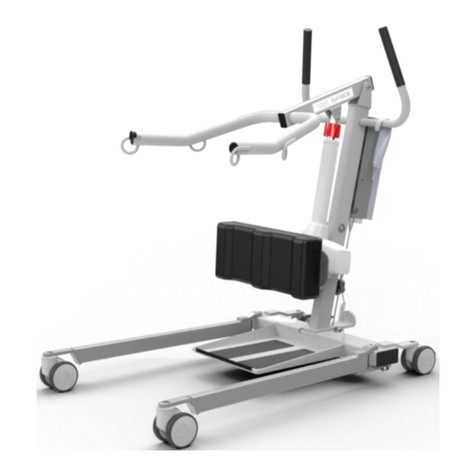
Mackworth
Mackworth SA180E User manual
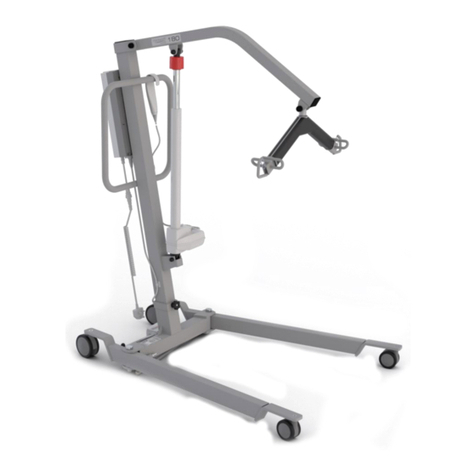
Mackworth
Mackworth 180 Mobile Hoist User manual

Mackworth
Mackworth M180 User manual
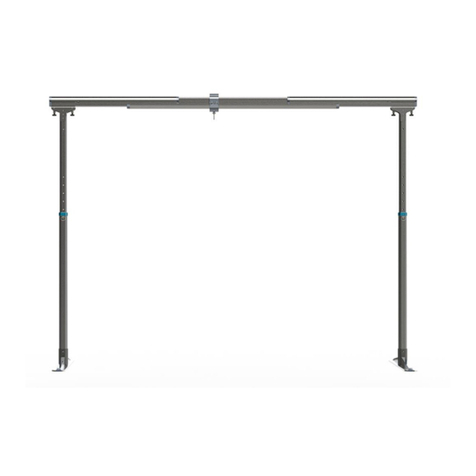
Mackworth
Mackworth FSG Quick start guide
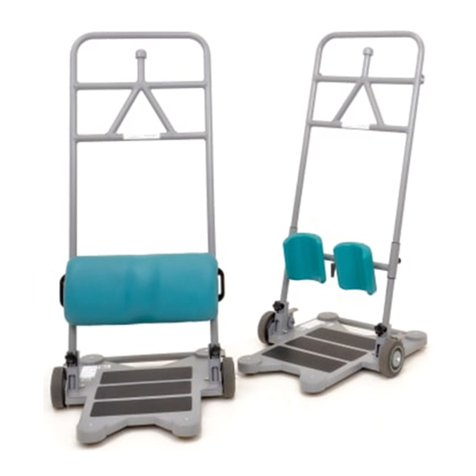
Mackworth
Mackworth Raiser User manual
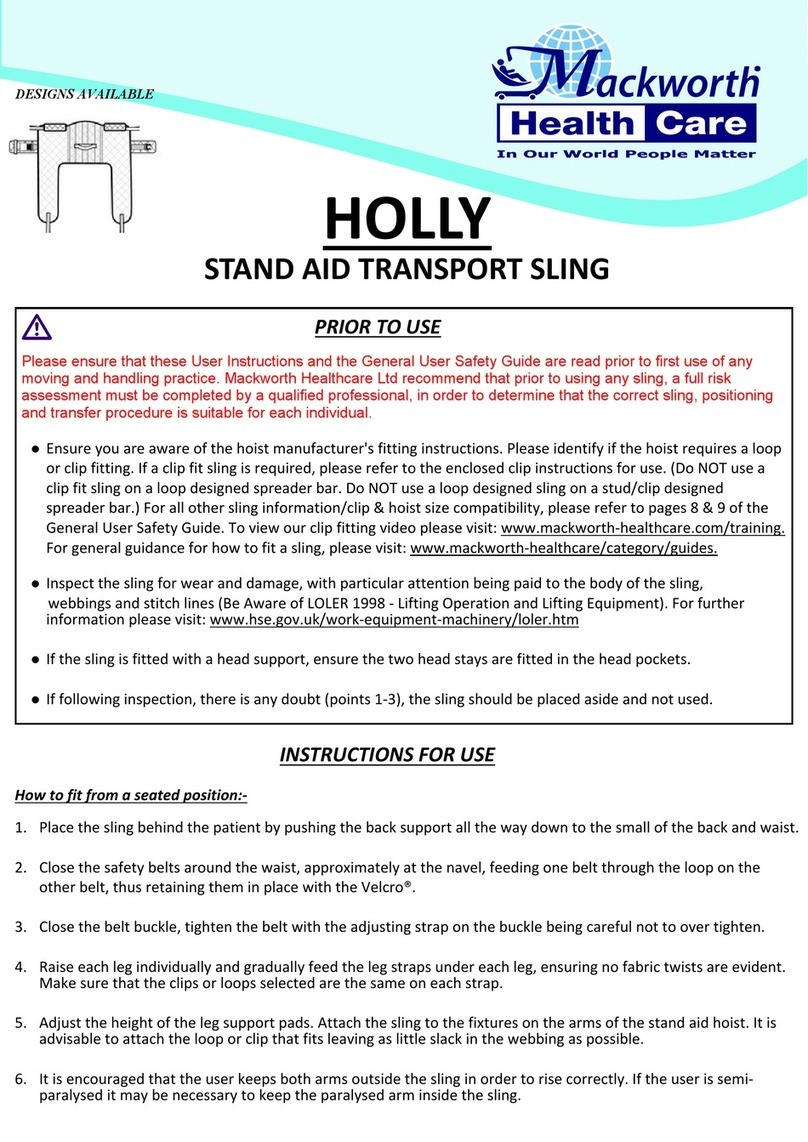
Mackworth
Mackworth HOLLY User manual
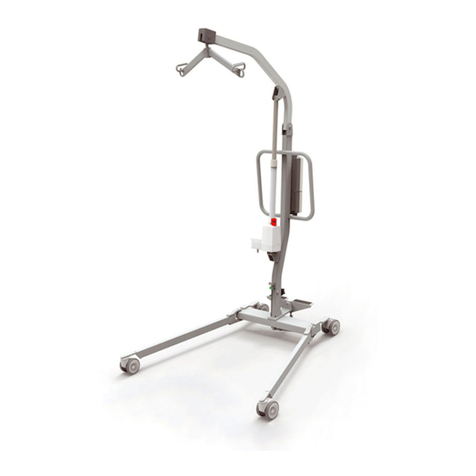
Mackworth
Mackworth M Series User manual
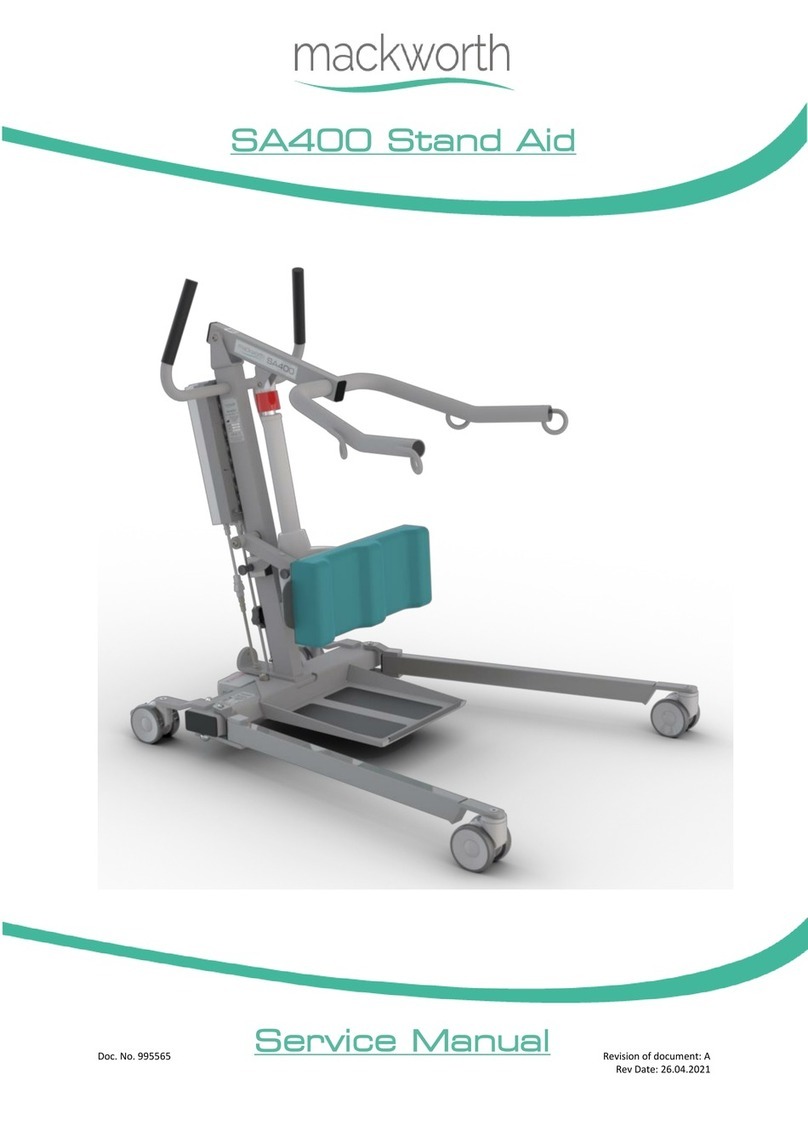
Mackworth
Mackworth SA400 User manual
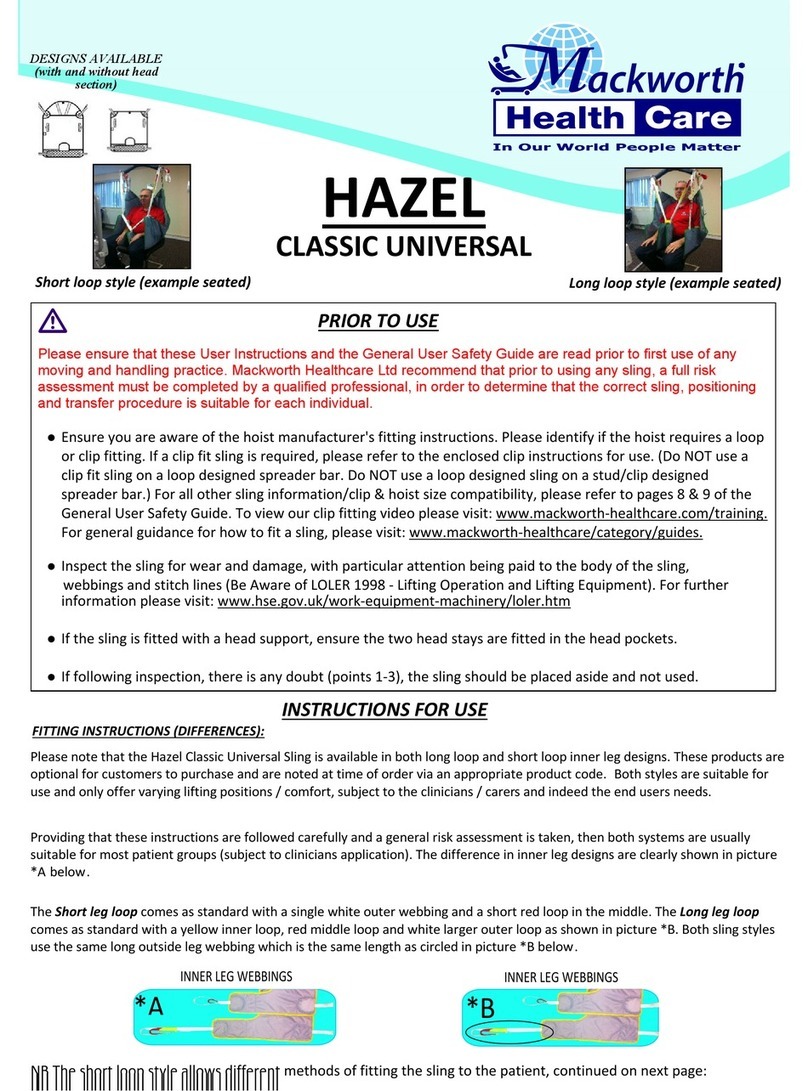
Mackworth
Mackworth Hazel Classic Universal User manual
